Guernica by Picasso has been a great source of inspiration for many Basque painters and sculptors. Others knew him before he painted this universal picture. This work also inspired Basque artists from other fine arts such as literature or cinema; but I still have them in the research phase for future articles in this same blog. In this first part I expose only what is related from the arrival of Picasso to Paris until the beginning of the Civil War in Spain in July 1936.
Guernica by Picasso: framing the theme.
Picasso’s Guernica was always among the main themes that I reflected on more than 10 years ago to create and attract clients to the private and personalized tour guide service that I dedicate myself to in the Basque Country. But reality was not as I perceived it then. Neither the gastronomy, nor the quality of the Rioja wines, nor the Basque (ancestral language of the Basques), nor the fact that Elcano was the first to travel around the world, nor the world-renowned Basque painters in the world of art, nor Picasso himself helped me attract clients in my first years with the Aitor Delgado Tours brand.
Many of my clients know about the existence of Picasso and Guernica. However, it has always struck me that few know that Guernica is a place, nor that this is a town that exists in real life. Much less, that Guernica is a town that exists in the Basque Country. Currently the name of the town is: Gernika-Lumo. The circumstances in which the bombing of Guernica in April 1937 and other Basque towns such as Durango, Ochandiano or Bilbao occurred, and not in other cities in Spain, are not very clear either. There are those who still confuse the Spanish Civil War with the World War. If you want to clarify ideas or go deeper into these stories, contact me and together we will design the private and personalized tour that best suits your time and interests. And all your doubts or half doubts…will disappear!, in a relaxed and fun atmosphere.
Luckily, Guernica by Picasso has become an important theme to offer my clients in recent years. The current controversial interpretations that are being made of the person and life of Picasso have allowed interest in this artist to increase. Also for the multiple activities, events and information carried out in 2023 on the 50th anniversary of his death on April 8th, 1973. In addition, the increase in quality in the dissemination of Basque universal themes by government, cultural and tourism entities has led to Guernica positioning itself as an essential city to visit in the Basque Country and in Spain.
Another important source for making this post has been the exhibition “Picasso sculptor. Matter and Body” which has been on display since May at the Picasso Museum in Malaga and can be seen at the Guggenheim Museum in Bilbao from September of this year until January 2024.
In homage to Picasso and the people of Guernica, 50 years after the painter’s death, I wanted to investigate more about the influence of Picasso’s Guernica painting on the life and work of some Basque painters and sculptors. And in this post I will try, in summary, to inform you of the “other Guernica” (a name that is not mine, but it fits what I want to convey to you) created by the best-known Basque painters and sculptors. I also include some that I did not even know existed but whose works I found interesting to share. I have had to select the painters, and some sculptors, in which the influence of Guernica by Picasso is undoubted. And others, where the theme and Picasso’s work have prompted them to create their own versions, somewhat removed from what Picasso created. Luckily some specialists, scholars, art critics… Basque, Spanish and from other nations that I will mention have investigated the subject and have been of great support to me. Thank you for his contributions and the ones you can give me!
I dedicate the first part to the Basque painters and sculptors who were associated with Picasso before the Civil War broke out in Spain in July 1936. And the following ones, to the period that covers the entire Spanish Civil War, which includes the moment of the presentation of Picasso’s Guernica; and to other periods where the work had a great impact on Basque society and culture. Finally, what was created after Franco’s death in 1975 until the end of the 20th century; and what this new 21st century offers us in the Basque cultural scene.
…“All of Picasso’s previous work is nothing other than the slow preparation of a great message, or the initiation of a great prophecy”. Juan Larrea, Basque writer.
Basque painters and sculptors related to Malaga before Guernica by Picasso
From 1900 to July 1936, just before the Civil War.
The presence of Basque painters in Picasso’s life was present as soon as I began to inquire about him and his work. Even before he painted Guernica in June 1937, he had contacts with some Basque artists and with the Basque Country.
In this first post, which will be the first part of the 5 planned, we will cover the period from the beginning of the 20th century to the moment just before the start of the Spanish Civil War in July 1936. And I will introduce each of the Basque painters or sculptors who have been most closely related to Picasso, mainly personally, and also through their professional works. Remember that the objective of this post is to inquire about Guernica of Picasso and its influence on Basque painting, but this will not happen until it is publicly shown in June 1937.
Since the early years of the 20th century, Picasso’s first works could be seen in Bilbao in the first two Modern Art Exhibitions of 1900 and 1901, organized by painters and sculptors from the Albia Schools. In addition to Basque artists such as Iturrino, Zuloaga, Regoyos, Guiard, Guinea,… there were also paintings by some Catalans such as Pichot, Casas, Oppiso, Rusiñol,… and Europeans, including Gauguin, Lund, Cottet,…
Painter Francisco Nicolás de Iturrino González (1864-1924)
In 1901 Picasso traveled to Paris for the second time at the request of the art dealer Vollard for his first exhibition outside of Spain at only 19 years of age. In this presentation of his works at the Ambroise Vollard Gallery, the Basque-Santanderino painter and engraver Francisco Iturrino, who was also promoted by the French, also participates. And not only did they find themselves exhibiting together on that occasion, they did so on several occasions. They also developed a beautiful friendship until Iturrino’s death in 1924.
The color poet, as some call Iturrino, was also a close friend of Matisse and Derain, which helped him a lot to find and perfect his own style. Together with the Basque painter Juan de Echavarría, they introduced Fauvism to Spain. He broke with realism and the Black Spain of his Spanish contemporaries, being one of the first to introduce the new avant-garde currents in the Iberian Peninsula. His favorite subjects were solitary or group women, clothed and naked; and gardens, flamingos, bulls and horses. The bullfighting hobby and painting, I am sure, were topics of discussion with Picasso; although also with Van Dongen, Vlaminck, Renoir, Derain and especially with Matisse and the Basque Zuloaga.
«(…) one day there will be a school that will bear the name of Iturrino, that future generations, cultivating it with love, will take it out of the abandonment in which it lives today to illuminate it with the glow of merit and adorn it with the laurels of glory”. Henri Matisse with Francisco Ulacia in conversations for the newspaper El Liberal.
Iturrino was not only loved, but also inspired many other painters who used him as a model for his paintings, such as Derain, Giacometti, Echevarría,… and Picasso himself. At the beginning of the century, Iturrino and Picasso not only shared the preparation of their future joint exhibition in a professional sphere, but also in a personal and neighborhood one. Both were neighbors on the Boulevard de Clichy, so I believe that it was at that time that they began to strengthen their friendship and professional relationship.
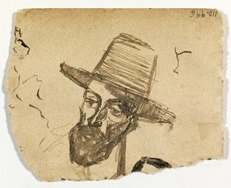
Francisco Iturrino painted by Picasso, 1901
A documented example of his contacts was the pen and ink drawing on paper that Picasso made for Francisco Iturrino in 1901 and that the man from Malaga would donate in 1970 to the Picasso Museum in Barcelona, 3 years before his death. He accompanied him almost all his personal life. (See the website of this museum in the section dedicated to “Friends“).
In addition, thanks to the part where the works are listed, in the Invitation written by Coquiot for the “Exhibition of paintings by F. Iturrino and P.R. Picasso”[1] that the library of the Picasso Museum in Barcelona kindly sent us, it is know that Picasso presented a painting in which he had painted Iturrino. Occurring between June 25 and July 4, 1901, it was Picasso’s first outside of Spain, but not Iturrino’s. The Basque-Santanderino had already exhibited in Brussels and Paris. In the title and in the order of presentation of the artists in the catalogue, Iturrino is always mentioned first, since he was already a well-known painter in Paris since 1895 and at the age of 36 he was at the beginning of his stage of professional maturity.
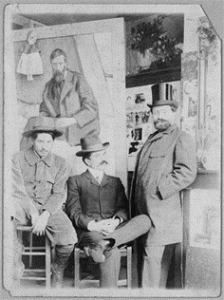
Picasso, Manach & Torres Fuster. With a Portrait of Iturrino on the wall, 1901
In the second list of the Coquiot document with Picasso’s works, Self-portrait appears first, and the second painting is Portrait de M. Iturrino. Today this painting does not exist, but its whereabouts are known. The canvas of this 1901 portrait was reused by Picasso in 1905 to paint The Acrobat with the Ball (exhibited at the Pushkin Museum and later purchased several times by private individuals). In those days Picasso’s economy was not very abundant; or said in more accurately, he was a poor man and still had many needs, so he had to recycle canvas a lot.
Luckily, a photograph[2] is kept in the Musée National Picasso-Paris in which the recycled portrait of Iturrino appears hanging on the wall, together with Picasso, the Catalan art dealer Pere Manach and the painter Antonio Torres Fuster in the studio on Boulevard de Clichy in Paris.
The invitation to the Iturrino-Picasso joint exhibition of 1901, written by the critic Gustave Coquiot, begins with the following sentence: Here we have two painters, fortunately very different: one barbaric, almost hostile, who represents the roughest human aspects and wild landscapes on rough canvases; the other more attracted by diverse themes, perhaps more restless. He then focuses on the works presented by Iturrino with his legendary Gypsies and the beggars of Spain… concluding that the Basque painter has contributed a decisive originality of a naive and penetrating temperament.
The presentation of the young Picasso begins with this sentence: Very different is the youthful, abundant and varied, “Parisian” exhibition of Don Pablo Ruiz Picasso. Coquiot focuses on the variety of themes that Picasso addresses, generally represented. And he considers that in this “way”, this agile and somewhat hurried style, one quickly realizes that Mr. P.-R. Picasso wants to see everything, he wants to express everything… He is a light-colored harmonist, but a little desperate, a little impatient, who he finds everything still armed, awake and ready the next day.
Coquiot ends his presentation by thanking both painters for getting out of the “disturbing” manolas and the “beautiful” guitarists… Messrs. F. Iturrino and P.R. Picasso have rightly thought that it was better to offer places and people selected by them, authentic physiognomies, precise and honest expressions of art, without worrying about easy seduction and superficial success. The day after the opening, Arsène Aleixandre published in Le Figaro: “Iturrino and Picasso bring very different characters. The first is serious, concentrated and a little wild and has a true sense of grandeur”[3] Much is known about Picasso.
Iturrino leaves Paris before the exhibition ends in July due to commitments in Salamanca and with the Bilbao Modern Art Exhibition of 1901. In addition to his work, Iturrino brings 3 paintings that Picasso had commissioned him to bring from Paris to this show. There are some curators or art critics, among them the Basque Kosme Barañano, who affirm that in that period it was usual to find works by Iturrino and Picasso together in galleries. And I say: luckily it is a situation that today has recovered.
In 1902 they also shared space in a collective exhibition at the Berthe Weil Gallery in Paris. In which the Basques Manuel Losada and Ignacio Zuloaga also present, about whom I will comment later on their relationship with the man from Malaga. Also in June, just one year after the joint show with Picasso, Iturrino held his second exhibition at the Vollard Gallery, but this time it was individual.
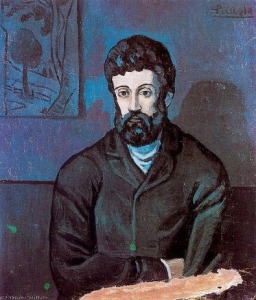
Portrait dhomme by Picasso, 1902-1903
Between the years 1902 and 1903 Picasso painted the oil painting Man in Blue. For the Picasso Museum of Paris it is just a “man’s portrait“. However, for Bárbara García Menéndez in her article “A face in the shadow” that she publishes on the website of the Carmen Thyssen Museum in Malaga, this man is Francisco Iturrino.
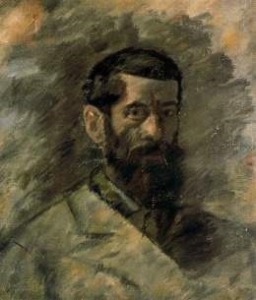
Selfportrait by Francisco Iturrino, 1903
I can share this perception not only because of the resemblance to the Basque painter, but also because Bárbara brings us a Self-portrait by Iturrino from 1903 (from a private collection) that allows her to be convincing.
In 1904 Picasso settled in Paris. The circle of Spanish artists who lived in the city on the Seine was significant, including the Basques Francisco Iturrino, Ignacio Zuloaga, Juan Echevarría and occasionally Gustavo de Maeztu. Besides Pablo Picasso there were Joaquim Sunyer, Hermen Anglada-Camarasa and Daniel Vázquez Díaz. The Basque sculptor Paco Durrio was also part of the group, and although he was born in Valladolid, from a young age he lived his life associated with the Basque Country, in a similar way to Iturrino. Durrio maintained a short but very close relationship with Picasso until the former’s death.
The Basque-Santanderian artist had a continuous presence in the Vollard Galleries during the first decade of the 20th century. However, I have not found any information that would allow us to affirm that there was a second Iturrino-Picasso joint exhibition promoted by this gallery or another in Paris.
n 1914 Iturrino was painted in oil by André Derain, a work that can be seen at the Centre Pompidou. Some 40 years later Alberto Giacometti would make his engraving Hommage à Derain. Portrait d’Iturrino, in which, by paying homage to his idol, Derain replicates the oil painting of the sad and Goyaesque figure of Iturrino (a work that is also in the Pompidou). He also painted his friend Matisse in etching. A year in which Picasso met, in addition to Paris, Iturrino, Matisse, Derain, and other painters and artists in the French Midi.
With the start of the First World War in August 1914, many Spaniards returned to Spain, Iturrino among them. In 1915 he presented his work for the first time in a collective exhibition at the Galerías Layetanas in Barcelona, which also included works by Picasso. In the Revista Vell i Nou of March 1, 1916, we are informed that… Corresponding to the visit that the Basque Caravan must make tomorrow to the Layetanas Galleries, it has been organized with exhibitions by artists from Vasconia, one by Darío de Regoyos, and the other by the Arrúe brothers[4]. It is the prelude to the relationship that the Association of Basque Artists would initiate with the Catalan counterpart association.
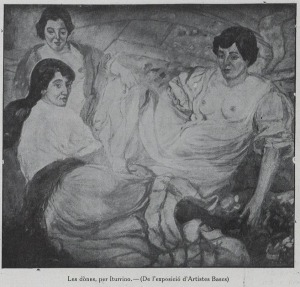
The women by Francisco Iturrino. Basque Artists Exhibit. Galerías Layetanas. Barcelona, 1916
On December 15, 1916, an art exhibition was inaugurated in Barcelona by the Association of Basque Artists invited by the Galerias Layetanas. The cover was adorned with the work Los juguetes by the Basque Antonio de Guezala. Photos of some of Iturrino’s works appear, such as: Las mujeres, Una forada (in Catalan), a drawing of women with shawls and combs, and another of women walking between cars. And photos of other Basque works by Darío de Regoyos, Juan de Echevarria, Rochell, Loygorri, Uranga and Lucia O. de Urbino. They mention Darío de Regoyos, the Zubiaurre brothers, the Arrúe brothers and Gustavo de Maeztu as already known to the Catalans. But they never had a joint exhibition of different temperaments of Basque art been presented[5]. Right at that very moment, an exhibition of Catalan art was being presented in Bilbao as a counterpart.
About Iturrino the magazine exposes: he is one of the most interesting and restless artists that we have in Spain. Iturrino’s work, which is the most complete in the entire exhibition, is somewhat disconcerting. He already presents himself to us with flat figures, like a poster, with light inks, he already expresses a movement, an agitation, an impression that could be called a direct line from the first Lucas; he already shows us some nervous, brief drawings; and some exotic landscapes, of warm color, made with a single shot of a brush. There is nothing weighted in Iturrino’s paintings. There is no measure or weight. There is no balance. Everything is the product of a vision that sometimes gives us a masterpiece, fresh, original, alive, or gives us a poor run-of-the-mill sample. An entire room fills the Iturrino and he takes, due to his abundance, all his honors.
Iturrino’s third exhibition in this Barcelona gallery is in 1917 with an individual retrospective, in parallel to a French Art Exhibition. An article in the Revista Vell i Nou of June 1917 informs us that:
… Now, coming back again, he seems to have ascended in his way. … These gardens of Malaga are seen by eyes that are more than Basque, Andalusian; more than Andalusians, Africans. … The two landscapes, also from Malaga, are somewhat more misty, and the roofs of the old city seem to be covered by a Parisian sky. Of the other paintings, dogs, bulls, horses, in our opinion the latter are of extraordinary interest. And for our fans, Francesc Iturrino now also has more value than the first lap.
At the time, Picasso, at the age of 37, was returning to this city from Italy with what he would be his first wife, Olga Koklowa.
There is evidence of a meeting that took place in the cellars of the gallery where Picasso was honored, but also two Basque painters: Francisco Iturrino and Gustavo de Maeztu[6]. The 3 honorees appear in the photo seated in the wooden seats, with Picasso in the middle, Maeztu on the left of the photo, and Iturrino on the right without his well-known beard, who was already 52 years old but maintained his elegant demeanor.
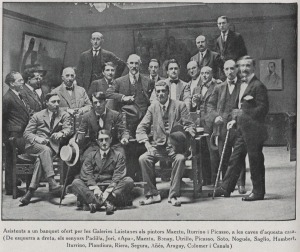
Photo of Iturrino, Picasso, Gustavo de Maeztu and other artists. Layetanas Galleries. Barcelona, 1917
In 1918 Picasso and Iturrino met again at the Galerias Layetanas; in which the Basque surprises with paintings of him with nude women that were strongly criticized by some part of the critics and the public, unaccustomed to somewhat risqué displays of sensuality[7]. These works were presented in the exclusive fortnightly Exhibition that the gallery held for renowned painters.
The works of Picasso and Iturrino are seen together again in Bilbao, along with others by Basque painters such as Juan de Echevarría, Darío de Regoyos, Losada, Arteta, Tellaeche, Guezala, Ignacio Zuloaga…, at the International Exhibition of Painting and Sculpture from August 30 to September 15, 1919 in Albia. They also exhibited Van Gogh, Matisse, Cezanne,… For the art critic Juan de la Encina, there were at that time 3 “capital centers of artistic production in Spain: Madrid, Barcelona and Bilbao”. Of course, Bilbao was the most “modest and silent”[8]. This exhibition is recognized as the precursor to the creation of the Bilbao Modern Art Museum created in 1924, which would later form part of the Museo de Bellas Artes de Bilbao that we know today.
In 1920 Iturrino began to suffer the first symptoms of gangrene in his house, for which in 1922 his leg was amputated. His economic situation was terrible and his friends organized a tribute exhibition at the Rosemberg Gallery in Paris. The exhibition consisted of 19 paintings by Iturrino in which, among others, paintings by Picasso, Derain, Matisse, Bonnard, Pichot, Dufy, Vlaminck and Signac were auctioned. In a letter he wrote to his son Marcelo, the Basque wrote: “… the life I lead and what I think is very sad. Picasso comes to visit me constantly and he is going to do a portrait of me in this hospital bed, and with this ordinary shirt that they give us, he says that I have a lot of character… ”[9].
I am not aware that this portrait of Iturrino in bed was done by Picasso or another colleague. Nor am I aware of any other details of his life that link him to Picasso, except that the two must have kept in touch in Cagnes-sur-Mer (Nice) until the death of Francisco Iturrino in June 1924. In this city he had the support of his friends Matisse and Renoir. He also had the support of a lady with whom he lived and had a son. The foregoing became known to the public in 2016, following an investigation by Charles Fremaux in which he also found his mortal remains in the Haut-de-Cagnes cemetery.
There are many individual collectors who own some of his works. Works of his authorship can also be found in the Fine Arts museums in the cities of Bilbao and Santander, in the Reina Sofía National Art Center in Madrid, and in the Zuloaga Museum in Zumaia, in the Basque Country.
Painter Gustavo de Maeztu y Whitney (1887–1947)
The painter and writer Maeztu, at the age of 19, meets Picasso during his first stay in Paris between the months of April and June 1907, just when Picasso was painting “Les demoiselles d’Avignon“. at the age of 26. His trip to the French city was intended to delve into the local culture, especially the artistic one. In addition to being accompanied by his great friend Tomás Meabe, he also hangs out with other Basques, especially Paco Durrio and Ignacio Zuloaga. It is very likely that this group was the one that led to the meeting between Picasso and Maeztu. Maeztu also discovered in the Louvre Museum Spanish painters such as El Greco, Ribera, Velázquez, Zurbarán or Herrera El Viejo.
Bilbao was always a determining place in Maeztu’s life, although he was born in Vitoria-Gasteiz, as was Estella (Navarra) at the end of his life. In his role as a traveler, trying to incorporate life experiences and knowledge, he also got to know London and Amsterdam; and areas of Castilla, Navarra and Andalusia in Spain. None of those trips encouraged him to delve into the new avant-garde airs of those times, such as cubism or surrealism. He was interested in large dimensions, whether in oil or frescoes. And he loved strong colors and contrasts. According to Candela Vizcaino:
…The protagonists of Maeztu are the typical types of Castile and Andalusia, the women of the common people who adorn themselves with regional garments, against the background of the eternal landscape of farmhouses and ruins. His models are treated with exaggerated curves and roundness, giving them a point of third dimension, as if they were sculptures[10].
Maeztu will continue to visit France from his residence in Bilbao, not only to Paris, but also to Biarritz, Saint Jean le Vieux, Bayonne,… where he nurtures not only his facet as a painter, but also as a writer of novels. In 1911 the Association of Basque Artists was created in Bilbao, with the painter Alberto Arrúe as president of the Board of Directors, and as members the painters Gustavo de Maeztu, Julián de Tellaeche, Aurelio Arteta, Antonio de Guezala and Ángel Larroque; the architect Pedro Guimón and the sculptor Quintín de Torre.
Since 1914 relations between Basque and Catalan artists have been strengthened through the Association of Basque Artists and its Catalan counterpart. This encourages many Basques to start exhibiting their works in Barcelona in a more current and orderly manner. In addition to the Basques Regoyos, Zuloaga, Mogrobejo, the Zubiaurre brothers, Iturrino,… Maeztu also arrived to Barcelona.
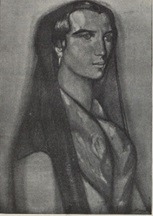
Sembradora Augusta by Gustavo de Maeztu
His first exhibition in Barcelona was held at the J. Dalmau Gallery in May-June 1914. In June 1915 at the Sala Can Parés[11] he presented a work that Barcelona critics compared with that of the previous year because…his works drew attention; despite showing a great imbalance, they gave the impression of an unusual vigor, of a well-oiled brush[12].In June 1915 he already presents… a more complete and finished painting. Rich, above all, the matter; well understood, worked and firm the conception of the work, which can be loved for itself. There is no hesitation now. The brush strokes are put in with full knowledge. The color is not flashy; It has like a soft rest. He has fled from all literary attributes, from all that is easy to paint, to give us a full and healthy vision of art without a strident note. And he shows us a photo of Serra of his painting Sembradora Augusta. In October of that year, Picasso exhibited his work in an exhibition of the Plandiura Collection organized by this same magazine.
In 1917 Maeztu is invited to exhibit individually at the Galerías Layetanas in Barcelona, and achieves resounding success. During his constant trips to Catalonia, Maeztu endears himself to the locals thanks to the great personality of his works. They considered him bold and brilliant; a sultry of color.
As we have commented, and exposed in a previous photo, Maeztu receives a tribute in the cellar of these galleries together with Picasso and Iturrino in 1917. A notice appeared on page 425 of the Magazine “Vell i Nou” of June 1, 1917 informs us that: Gustavo de Maeztu, the well-known painter from Bilbao, so much discussed and appreciated everywhere, is in Barcelona. He has come to visit the French Art Exhibition and probably to exhibit paintings, which would be of great size, in the Layetanas Galleries.

Portrait of Gustavo de Maeztu by Picasso, 1917
On July 1, 1917, a Retrat a la mina de plom, d’En Gustau de Maeztu (Portrait of the lead mine by Gustavo de Maeztu) painted by Pau Ruiz Picasso appears on the cover of the Vell i Nou Magazine. The signature reads: To the friend Maeztu, Picasso. June 1917.
In that same number, on the next page, there is a Portrait of the Lead Mine, by Mr. Vollard, also by Picasso.
The magazine also continues to publish texts by other authors such as José Junoy in which he states that: Picasso, where he puts his hand, leaves a trace of his genius temperament. Gifted like no other for assimilation…. I have never seen such complexity in any artist, nor have I seen such an irresistible almost magical force. Picasso understands things without loving them, and interprets them cruelly. His love is domination.
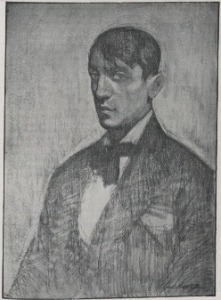
Portrait of Picasso by Gustavo de Maeztu, 1917
And immediately Retrat d’En P. R. Picasso, carbó per Gustau de Maeztu appears in print. Portrait of Pablo Picasso, made by Gustavo de Maeztu. The original is carbon/paper, dated 1917. Provenance: private collection.
A charcoal portrait of Picasso by the Basque painter Maeztu!
Honestly, this relationship did surprise me a lot. Perhaps my astonishment comes from what we already know today about the political position of these two characters. Possibly in that period both were more immersed in their professions than in the political life that they later showed.
This year, the Catalan critics publish in this magazine that… Gustau de Maeztu is a great decorator of exuberances, he is a painter of meats full of maturity and promise. He is, in another sense, an example of encouragement for young artists. And his face is triumphant in his paintings, like Euskadi, his town, is triumphant in the face of his children: those red like his cloth. You have to talk while painting, you have to paint everything by talking, and do strong painting. The technique is precise and delicate, and the landscape robust as if it were from a fertile land. Gustau de Maeztu has also made some portraits, in charcoal, which he exhibits in these rooms[13].
Far removed from his triumphs and good reviews in Catalonia, Maeztu lived in his Bilbao with some regret over the few sales of his works in the city. A phrase of his is known in which he indicates that “this is not my kingdom, here little is understood about art” referring to Bilbao[14]. It is when he decides to move away from the town and settles in London between 1918 and 1922. At the same time, some of his works are shown at the International Painting Exhibition held at the Berástegui Schools in Bilbao in the summer of 1919. Paintings by Picasso, Renoir, Cézanne, Van Gogh, Gauguin,… and other relevant painters are also present.
With greater maturity than when he made his first stay in Paris, Maeztu feels more akin to the artists and unknown worlds that London offers him. The Gustavo de Maeztu Museum in Estella (Navarra) summarizes this stage in this way:
The Chinese of Maeztu are the shippers of the port of Liverpool, of many-sailed adventurous ships; the Piccadilly wanderers; the long-ponytailed Chinese jongleurs, who are displayed on stage; the hieratic Chinese of the sordid opium dens. Wandering and mysterious Chinese who share with the Jews and the gypsies, the enigma of the scattered races, without cradle or homeland…. Maeztu returns from London more stabilized, with a more serene technique and a sharper sensibility… .. A period of splendor begins now for our artist, of recognition of his quality and his prestige, especially outside the Basque Country.
In May 1922 he shows his new pictorial creations at the Galerie Devambez. At which point I presume he came into contact with Picasso again, but I don’t know. Although the works had already proven their validity in the United Kingdom, Paris again leaves it aside. The exhibition is not very visited.
However, 1922 will be a year that will bring him the definitive professional breakthrough in his native land. In September he participates with 6 paintings in the III Congress of the Basque Studies Society in Guernica. Here he presents the famous painting of him Basque Land, Lyrics and Religion that will finally be acquired to be placed in the prestigious Casa de Juntas de Bizkaia in Gernika (Guernica). 5 sailors with their oars and rudder navigate a boat along the cliffs of the Basque coast.
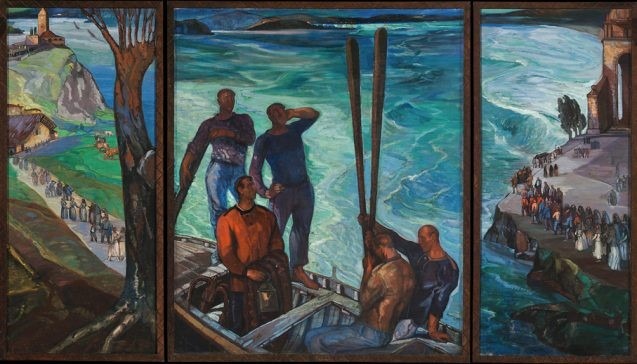
Basque land, lyric and religion by Gustavo de Maeztu
According to Basterra, «it is one of the pieces of Euskalduna painting, in which the characteristics of Nordic painting stand out most courageously. It is painted with rhythmic blows of a passionate heart. The energy in which those men of the oars abound is exhaled in magnetic glances and an overflowing stream of vigorous songs. This triptych is, without a doubt, one of the most important products of the Basque school“. Text from the website of the Gustavo de Maeztu Museum.
Barcelona sees his works again for 3 years in a row from 1933 to 1935 at the Catalonia Bookstore, the Emporium Gallery and again at the Laietanas Galleries. During 1933 and 1934 in the Sala Parés the works of the collection of paintings by Miguel Utrillo were shown, in which, in addition to Picasso and Maeztu, there were others such as Dalí, Cabanyes, Sunyer, Casas, Clará, Nonell, Opisso, Bagaría, Pasqual and Mir. These would not be his last presentations in Barcelona, it would be necessary to mention those of November 1941 at the Galería Pallarés; but on that occasion I don’t think he met Picasso in Catalan or Spanish lands.
Although Bilbao resisted him, he did not stop exhibiting in its halls, much less when the Association of Basque Artists itself gave the works of its members in exhibitions. It is known that his works were seen in the new gallery called Casa Arte on Bilbao’s Gran Vía, which opened in February 1936, with a sample of Basque artists. The second exhibition in this room was an exclusive one of 24 works (from 1908 to 1935) by Picasso, brought to Bilbao by the Catalan Lluís Carreras Macaya, who was the director of the room at the time. This first solo exhibition in Spain of Picasso was promoted by ADLAN (Amics de l’Art Nou) and was also presented in Madrid and Barcelona.
Just on those dates the Spanish Popular Front won the last elections of the Second Republic, and in July of this year there was a coup in Spain that led to the Civil War. I have not found any information that relates Picasso and Maeztu personally or professionally after 1936. Their political positions, and the personal and professional lives of both, seem to have never allowed them to meet again, although I would like to think that they always kept themselves informed about their respective lives and works. Maeztu stayed in Spain after the war was won by the Francoists, and died in 1947 in the town of Estella, in Navarra.
Painter Jesús Olasagasti Irigoyen (1907–1955)
I have not been able to exclude this Basque painter, born in San Sebastián, from this post, although I have not found enough information to assume that there was a close personal or professional relationship between Olasagasti and Picasso, such as with Iturrino, or only professional, such as with Maeztu. I will tell you what I have found, and if you have any other information or opinion about it, please do not hesitate to tell me.
Picasso was 26 years old and well established in Paris, with a growing prestige and enough followers and detractors when Olasagasti was born in 1907 in San Sebastián. The Basque was interested in drawing from an early age, and he had several teachers, including Julián de Tellaeche, another Basque painter who was also related to Picasso and who we will discuss later. His great tutor was Daniel Vázquez Díaz, a great follower and admirer of Picasso, whom he met in Paris through Paco Durrio in 1906. Vázquez Díaz taught him to work with the geometry of spaces and the little use of colors in his paintings, among other techniques. And, of course, cubism. Olasagasti’s great dedication to portraiture is fostered by Vázquez Díaz, encouraging him to travel to the United Kingdom to meet the best exponents of him such as Van Dyck, Gainsborough and Reynolds.
The Basque painters Olasagasti and Aurelio Arteta applied “cubism to figuration” according to Mª Jesús López de Sosoaga. In his doctoral thesis, Sosoaga continues, exposing that this application of cubism was carried out: within the geometrizing current that was in force in the European interwar period. Olasagasti was part of the group of painters from Gipuzkoa who from the twenties until the civil war painted with a modern language, which in the history of Basque painting supposes the link between the ethnicist painting of the preceding period and the avant-garde painting of the thirties,…. Jesús Olasagasti is one of the painters who went to Paris in search of other modern currents, eager to free themselves from costumbrista realism and who came closest to the European avant-garde, although attenuating its aesthetic advances. Olasagasti’s life will be a constant contradiction between the traditional and the modern, a continuous slide into duality”[15]
Before going to Paris for the first time in 1927, Olasagasti had already visited the United Kingdom and Italy; where he met the Bilbao writer and journalist Rafael Sánchez Mazas in Rome. It was the beginning of a determining friendship in his life. In 1926 he participated in the First Exhibition of Basque Artists held in Bilbao. His visits to Paris focused on learning everything new from the avant-garde and he lived with the cubists in Montparnase, as he revealed in an interview with the journalist Juan de Hernani. The journalist tells him that “in your beginnings you had cubist hobbies“, and he told him; “And I still have them”…”Cubism in Spain is still not enough to live on”…“here we are still on an islet of realistic painting. The world already paints differently… a cubist painting no longer makes you laugh out loud. Even before the other war, Picasso sold a lot in Paris”[16].
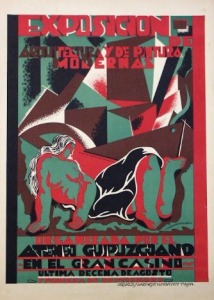
Poster of the Exhibition of Modern Architecture and Painting. San Sebastian, 1930.
At the age of 22, in 1930, Olasagasti managed to be present at the first exhibition in San Sebastián in which Picasso also exhibited. The collective exhibition of Modern Architecture and Painting at the Gran Casino was sponsored by the Ateneo Guipuzcoano, and is remembered as the most important held in Spain at that time.
In his organization he also cooperated with other artists, all subordinated to the coordination of the architect José Manuel Aizpurúa, who also managed the participation in the part dedicated to architecture. His great Basque friend Juan Cabanas designed the poster, as well as exhibiting and organizing the painting exhibition. There were also film exhibitions, and models and architectural projects were seen, such as that of Olasagasti’s own painting studio, designed by Aizpurúa. And also by the Catalan architect Josep Lluís Sert, who in 1937 designed and built the Spanish Pavilion for the Universal Expo in Paris where Picasso’s Guernica was exhibited for the first time.
“Bouteille marquée bas avec un as de trefle” is one of the 3 works that Picasso is known to have presented in this collective exhibition, in which he was not present. For his part, Olasagasti presented 2 still lifes and his famous “Portrait of Díaz Caneja“. In addition, paintings by an excellent cast of renowned international artists such as Miró and Juan Gris were seen; and from another Basque like the painter José María Ucelay (who was also related to Picasso).
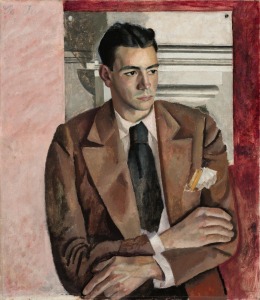
Portrait of Díaz Caneja by Olasagasti, 1930
“Portrait of Diaz Caneja“. 1930. Oil on canvas. 80.5 x 70.5cm. Signed: “To Juan Manuel Díaz Caneja. Memory of 1928. Year in which we became good friends”, J. Olasagasti (top left angle). It belongs to the collection of the Bilbao Fine Arts Museum since May 1932.
According to López de Sosoaga “…the construction is geometrizing, highlighting the grandeur and the articulation of the ornamental and the constructive. The architectural background is also reminiscent of the classical world…” And he expands that E. Carmona characterizes “the painting in “1925 Style” in which the avant-garde is combined with a modern figuration”.
It reminds me of Picasso because of the cubist air it has and because of the disproportions of the body with the head; especially because of the huge hands.
«Those exhibitions (1930-31) brought to San Sebastián and by extension to our Basque Country, the sensitivity open to avant-garde tunes in an area where conservatism and disorder prevailed, they opened up traditional artistic languages to modernity and, in the face of aesthetic fragmentation, facilitated ways where Basque art had the opportunity to access at the last minute». Opinion of the critic Iñaki Moreno Ruiz de Eguino in the newspaper El Diario Vasco, on April 9, 1996.
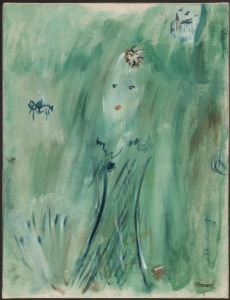
Portrait or Damita Verde by Olasagasti, 1931
Olasagasti participated in the “Modern Painting and Sculpture Exhibition” organized in the Great Kursaal by the Society of Iberian Artists in September 1931. Among the 3 works that he contributes, Portrait or Damita Verde (Oil on canvas, 80 x 61 cm, 1931) stands out, which is also in the Bilbao Fine Arts Museum. A creation with great influences from surrealism, which began to prevail in Spanish painting in the 1930s. On this occasion Picasso is not known to have sent works, but it is known of the participation of other Basque painters of the time such as Juan Cabanas Erauskin and José Mª Ucelay. Olasagasti’s most surreal painting is the “Portrait of the architect Aizpurua” in 1930, with whom he always had a great friendship, and they also shared his admiration for Picasso’s creations.
Starting in September 1931, the Society of Iberian Artists organized and carried out a tour of Europe with an exhibition of modern Spanish art from the Second Republic. Although a first exhibition had already been held in Copenhagen in 1928, they resumed in Berlin, to later go to Italy, Switzerland, Belgium, Holland, until Paris in 1936. Many renowned painters of the time participated in it, especially those with the greatest international projection belonging to the Spanish outpost in Paris: Bores, Cossío, Dalí, Juan Gris, Julio González, Ismael González de la Serna, Joan Miró, Peinado, Picasso, Gregorio Prieto and Pere Pruna. According to Javier Pérez Segura in Modern Art, Vanguard and State: The Society of Iberian Artists and The Republic (1931-1936), the precursors, the new values and the young promises were also included.
Thirty years ago, the group of those who began to initiate the plastic directions of art in our country, precursors or pioneers, included the Basque painters Arteta, Echevarría, Iturrino and Regoyos, as well as other Spaniards such as Canals, Sunyer, Vázquez Díaz, Nogués, etc. The new values that residing here (in Spain) were gaining prestige from new teachers, among others, grouped Maruja Mallo, Moreno Villa, Pérez Rubio, Ponce de León, Ángeles Santos, and the Basques Tellaeche, Bicandi, Ucelay, Guezala. Another group was dedicated to the young promises, those who promise and show no mercy, such as Esteban Vicente, Juan Esplandiú, Cristino Mallo,… and the Basques Juan Cabanas Erauskin and Jesús Olasagasti. Regardless of being present on the list of renowned Spanish artists, Olasagasti did not contribute any of his works for those exhibitions.
He maintained his presence in national shows such as the one held at the Emporium Galleries in Barcelona in March 1933 coordinated by the Association of Basque Artists. In addition, there were the Basque painters Gustavo de Maeztu, as mentioned above, the Arrúe brothers, Juan de Aranoa, Antonio de Guezala, Isidoro de Guinea, Manuel Lozada, Julián de Tellaeche, Pablo de Uranga, José María Ucelay, Bernardino Bianabe Artía and Jesús Olasagasti, among others. “La niña del yo-yo”, “Retrato” and “Toros”, are paintings that clearly reflect some of the themes that he presented in this exhibition and that characterize the artistic life of this painter.
On April 14, 1931, the Second Republic had been proclaimed in Spain with a left-wing government. But in 1933 the elections gave a right-wing government the winner, which led to the inauguration in San Sebastián in January 1934 of the first premises of the Gipuzkoan Falange, in which many of Olasagasti’s close friends were present.
“La niña del yo-yo” was the work that represented him at the National Exhibition of Fine Arts in the Retiro Park in Madrid in May 1934. I have not been able to discern, with certainty, if the man from Malaga also exhibited in this exhibition.
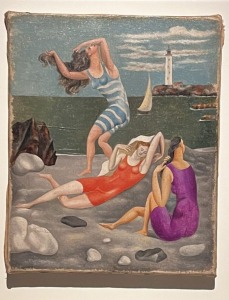
The swimmers by Picasso. Biarritz, 1918
Picasso, his wife Olga Koklova and their first son Pablo, already 13 years old, arrived in San Sebastian in August 1934, entering through the Spanish-French border at Irún-Hendaye. It is very likely that they have gone to Biarritz to spend the summer and see some acquaintances. They made part of their honeymoon there once they were married in Paris in 1918. From that moment is their painting “The Bathers” (Oil on canvas, 26.3 x 21.7 cm., Musée Picasso Paris).
So it could be said that Picasso not only painted a Basque subject with Guernica, he also painted the Basque Country! I love showing the towns of Guernica and Biarritz in the private and personalized tours that I do around the Basque Country. Do not miss them, they are worth knowing!
Olga and the man from Malaga hadn’t set foot on Spanish soil for about 17 years. On that trip they also toured the cities of Burgos, Madrid, El Escorial, Toledo, Zaragoza and Barcelona in their personal car. And they tried to go unnoticed.
On August 29, 1934, Olasagasti called his friends, the architect Aizpurua and the painter Cabanas, to inform them that he had recognized Picasso in a pastry shop in San Sebastian accompanied by his son. According to Carlos Ribera’s account, in “GU Memories: Picasso in the Old Town”, they took him to that area of the city. Then they ate at the Club Náutico, a Bauhaus-style building that had been rehabilitated by the architects Aizpurua and Labayen.
There is photographic evidence of that meeting in which the painters Jesús Olasagasti and Picasso appear on the terrace of the Club Náutico. The snapshot was published for the first time in issue 100 of The Great Basque Encyclopedia 1973-1983. The photo was owned by the family of the Basque painter Vicente Ameztoy (a disciple and relative of Olasagasti). Giménez Caballero and José Antonio Primo de Rivera also participated in the meal. Many of those present were members of the Falange.
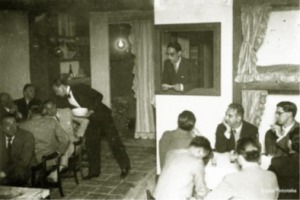
Opening up of GU, 1934
As can be seen in the photo, there is a hat peeking out from the left side, and from the looks of both of them and Picasso’s gesture, they are chatting animatedly with another person. I would dare to speculate that the photo could have been taken by the architect Aizpurúa, since he was a great lover of photography. Although this snapshot has served as testimony to Olasagasti’s relationship with Picasso on that day, there is no prior or subsequent record of a continuing personal relationship.
The Basque painters Olasagasti, Landi, Tellaeche, Montes Iturrioz, Martiarena, Kaperotxipi and Cabanas were members of the artistic-cultural-gastronomic association “GU” (which means us, in the Basque language) which was inaugurated that same night. It also included writers such as Pío Baroja, Berruezo and Tobalina; the lawyers Juan Pablo and Luis Lojendio; the photographer Marín and the musical composers Tellería and Garbizu.

Opening up of GU, 1934
The journalist Sanchez Maza gave a speech at the opening dinner, in which, in addition to many of those mentioned, Picasso was also invited.
In the photo of that inauguration act that I show you, I have the impression that the figure of Picasso may be present: the first one on the left side, against the wall and with one hand near his face.
In the local newspaper El Diario Vasco in April 1998, the journalist Mikel G. Gurpegui explained that during that visit Picasso commented that his stay in San Sebastian had taken longer than expected. He was shocked by the number of children lost on La Concha beach, a matter that he learned about through the lifeguards’ loudspeakers. He was in the Plaza de Toros del Chofre the days before the inauguration of GU, for which he made comments about the work of the bullfighters, whom he knew well, and he was amazed by the attendance of some students from the nuns’ school who also enjoyed the bullfight[17]. Upon returning from this trip through Spain, he had made several etchings related to bullfighting, among which is the “Blind Minotaur Guided by a Girl I“.
Joan Miró proposed in 1935 to the Catalan artistic movement ADLAN (Friends of the New Arts) the organization of an Exhibition on Picasso in the Sala Esteva in Barcelona. He had the support of Picasso himself and many other painters, as well as Spanish and French artists and intellectuals. The exhibition could be seen in Bilbao at the Art gallery from February 19 to 25, 1936 thanks to its owner: the Catalan Lluís Carreras Macaya. In the investigation[18] carried out by the Picasso Museum in Barcelona, there is no evidence that Olasagasti visited the exhibition, but I have no doubt that he did for various reasons. The Basque painter spent almost his entire personal and professional life between Bilbao and San Sebastián, he was well known by the members of the Association of Basque Artists, an active lover of everything cultural and was always a prominent admirer of Picasso’s art. An opportunity like this, I don’t think he missed it. 10 years later, Olasagasti also exhibited the last individual exhibition of his artistic life in this same room in Bilbao. This first major Picasso exhibition in Spain was also shown in Madrid a few days later, with a collection of 25 works spanning from 1907-1908 to 1935.
In the same month of February that Picasso exhibited his work in Bilbao, the Spanish Popular Front won the elections. 5 months later, on July 17, 1936, Generals Mola and Francisco Franco took up arms against the Second Republic. The Republican government informed Picasso in August of its appointment as honorary director of the Museo del Prado in Madrid, a position he never assumed. The Navarrese troops allied to Franco entered San Sebastián on September 13, and Olasagasti enlisted as a Falangist volunteer. The family does not know if he was ever affiliated with the Falange before the end of the Civil War, nor is he listed as a member of it in any known official or unofficial document. With Franco already in power, he was a member of the Falange, and advised the Crafts Service of the San Sebastián Education and Rest Union Work. The GU became the propaganda office of the regime.
He paints Generals Franco and Sagardia during the war. In this period, 2 of his paintings were pre-selected by the Basque painter Tellaeche to be shown in the Spanish Pavilion at the Universal Exhibition in Paris in 1937, but in the end they were not exhibited, although they were shown in an exhibition dedicated to Basque art that was held in parallel to that exhibition. He dedicated himself to portraiture, as his main theme, after the Civil War. At his wedding, in 1944, the Basque painters Ignacio Zuloaga and Gustavo de Maeztu were present. I don’t think he had any kind of subsequent relationship with Picasso since 1934. He died in 1955, aged only 47, from cirrhosis of the liver.
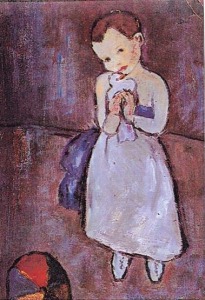
The boy of the dove. Atributed to Olasagasti
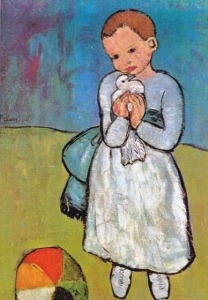
Boy with a dove by Picasso, 1901
“The Boy with the Dove” attributed to Jesús Olasagasti (on the left) and “Boy with a Dove” by Picasso.
As Sososaga tells us in his doctoral thesis on Olasagasti, there is a painting attributed to him that may be an error or an erroneous attribution. The painting is neither signed nor dated. He clarifies that regardless of whether it is by the Basque painter or not, the person who made the copy is undoubtedly a lover of Picasso and is not an apprentice[19].
After the death of the Basque, Picasso and Olasagasti have met again through their pictorial works in multiple exhibitions. The first was in the retrospective section Precursors and Masters of Contemporary Spanish Art at the III Hispano-American Art Biennial in Barcelona in November 1955, just recently after Olasagasti died. They repeat meeting his paintings in Seville in 1999 in the exhibition “From Picasso to Bacon: contemporary art in the Collections of the Bilbao Fine Arts Museum“.
«Painting is never prose, it is poetry, written in verse with plastic rhymes». Pablo Picasso.
Note: In order not to lengthen the presentation of this topic, I have decided to publish each of the parts as I finish researching and writing. Please, any contribution, precision, detail or suggestion to the exposed content is welcomed.
[1] “Exposition de tableaux de F. Iturrino et de P.R. Picasso: from June 25 to July 14, 1901” / Gustave Coquiot (pr.). 12 p.m. ed Galeries Vollard, Paris, 1901. Museu Picasso Library, Barcelona.
[2] I found the photo and the history of the painting published in an article called “A face in the shadow” by Bárbara García Menéndez, which appears on the website of the Museo Carmen Thyssen of Málaga dated February 26, 2019.
[3] Article appeared in the section “La vie artistique”. Published in “Le Figaro” on June 26, 1901. Cit. Moreno Ruiz de Eguino. Catalog of Francisco Iturrino. Kutza Foundation. p. 29
[4] Vell i Nou magazine, number 20, year II. March 1, 1916. Pages 10-12.
[5] Vell i Nou Magazine. December 15, 1916, Year II, number 39. Pgs. 319 to 321.
[6] In the text of the photo it says: Fig. 6. Attendees at the banquet offered by the Galeries Laietanes to the painters Maeztu, Iturrino and Picasso, in the caves of the house. From esquerra to dreta, Padilla, Jori, “Apa”, Maeztu, Bonay, Utrillo, Picasso, Soto, Nogués, Saglio, Humbert, Iturrino, Plandiura, Riera, Segura, Añés, Aragay, Colomer and Canals. Photograph reproduced in the publication Vell i Nou, no. 47, July 15, 1917, p. 474.
[7] Les Arts and Artists. Vell i Nou. Fortnightly Art Magazine – Year IV – number 60. February 1, 1918. Barcelona. P. 43, 44 and 45.
[8] Newspaper El Pueblo Vasco 9-20-1919.
[9] Letter from Iturrino to his son Marcelo dated Monday 5, 1922, cited by Puente, J.
[10] Text by Candela Vizcaíno | PhD in Communication from the University of Seville.
[11] Gustavo de Maeztu exhibitions according to the museum website with his name in Estella
[12] Vell i Nou Magazine. July 1, 1915. Year I, number 4. Page 11.
[13] Vell i Nou magazine, number 46, year III, p. 453. July 1, 1917.
[15] López de Sosoaga Betolaza, María Jesús. “Life and Work of the painter Jesús Olasagasti Irigoyen”. PhD thesis. April 2015. University of Deusto.
[16] HERNANI, J. de: “With Olasagasti at the Cultural”. The Basque Newspaper, 27.02.1949. pp.4-6.
[17] Gurpegui, Mikel G. (4/7/1998): Picasso for the Shell. Basque newspaper. Year LXII – No.20, 130), p. 60.
[18] DOMÈNECH, SÍLVIA: «PICASSO EXHIBITION» 1936: THE DISCOURSE OF THE ARCHIVE. Picasso Museum, Barcelona. Year 2011.
[19] López de Sosoaga Betolaza, María Jesús. “Life and Work of the painter Jesús Olasagasti Irigoyen”. PhD thesis. April 2015. University of Deusto. Page 254.

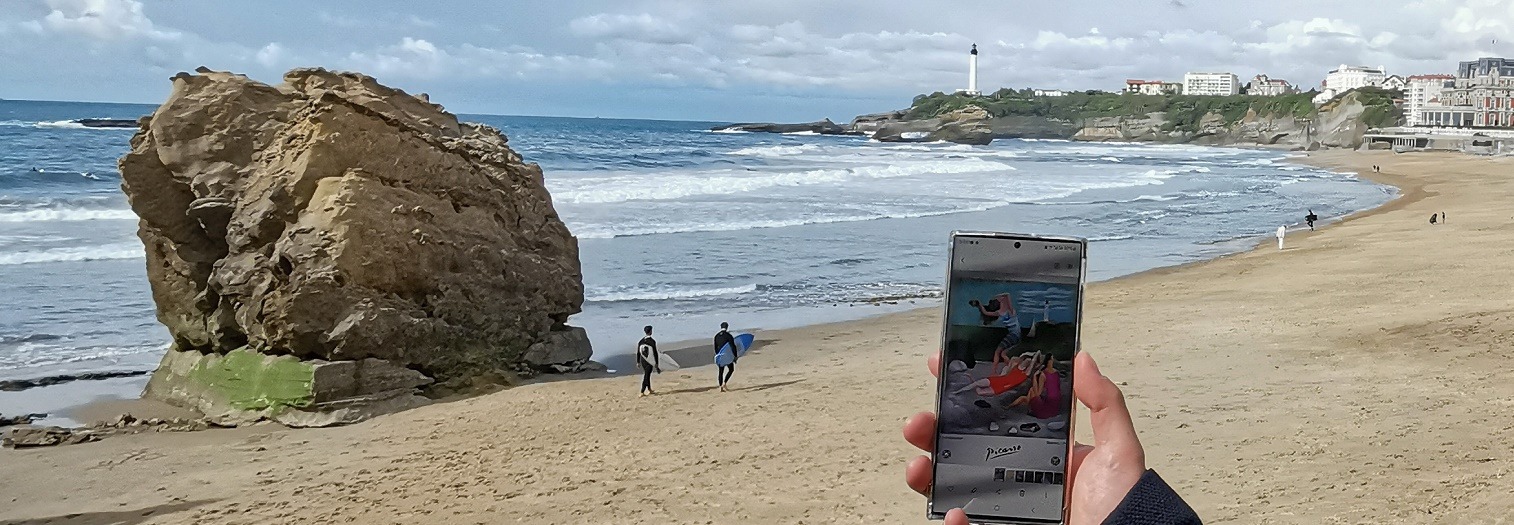
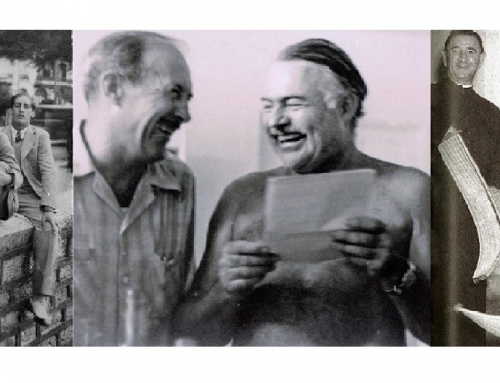
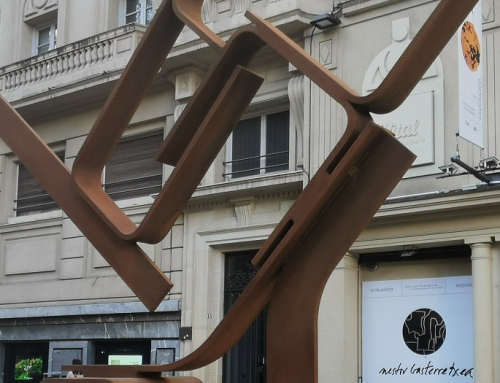

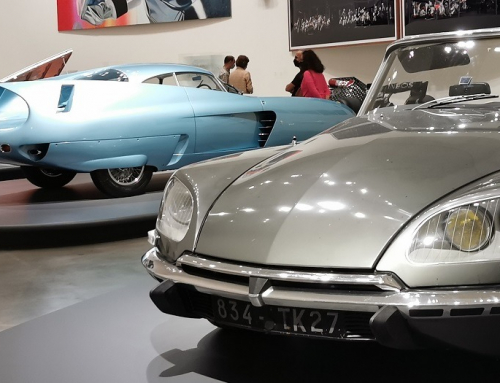
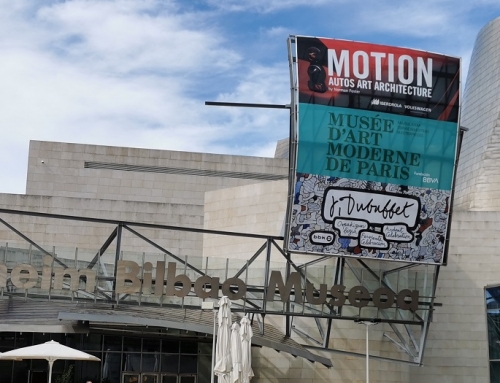


Leave A Comment